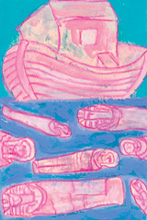Issue Archive
Commentary: Let There Be Windows
When Noah was building his famous ark, God gave him a strange instruction: “Make yourself an opening for daylight in the ark….” —Genesis 5:15.

Why a window? After all, the ark was about self-preservation. It was Noah’s vehicle to save himself and civilization from the evil that had overtaken the earth. The rabbis explain that Noah needed a window to look outside because he had to be sensitive to the suffering of the rest of humankind as well.
Noah’s window is something that I fear we have closed in the last three years. We’ve turned a deaf ear to the suffering of others because of our own suffering and insecurity. As a New Yorker living just a few miles from ground zero, I have felt especially vulnerable since 9/11. America was attacked on my home turf. I supported the war in Afghanistan and, at least initially, the war in Iraq. These countries were the battleground for the war on terror and defeating their regimes became my priority.
But as the war in Iraq dragged on I realized that it was time to start looking out Noah’s window. I looked and I saw the coffins of over 1,100 American soldiers. And that was only the tip of the iceberg. Tens of thousands of Iraqis and others had lost their lives. Meanwhile, in the Darfur region, thousands were suffering from disease and violence as the Sudan’s bloody civil war dragged on with no end in sight.
Perhaps the biggest wake-up call came in the closing days of 2004 when the giant tsunami hit 11 countries in Southeast Asia and washed away more than 294,000 lives. Whole villages were wiped out. And those who survived faced crushing poverty, disease and homelessness.
It is easy to distinguish between these events, to note that a tsunami is a natural disaster, an act of God, while the 9/11 disaster was an act of fundamentalist Islamic madmen. But no matter; the suffering of others helped me put my own suffering in perspective.
I suspect that is what Noah saw when he looked out his window. It couldn’t have been very secure in that fragile ark floating above the waters for 40 days and 40 nights. But looking out and seeing the world engulfed by water must have made Noah count his blessings.
To look out Noah’s window is to gain a Jewish perspective on the world. When I was saying the mourner’s Kaddish for my father several years ago, I was wounded and in pain. What I most wanted was to be left alone with my grief. But I found that by being forced to join with others my own grief was put in perspective. Yes, I lost my father, but there were others with losses, too. And as my year drew to a close, I was able to help new mourners who came to theminyan.
In a few weeks we will be sitting down to the Passover Seder. It is a moment where we vividly and even physically recall a national trauma by reenacting the Passover story. We taste the bitter herbs, eat the matza—the bread of affliction—and savor the wine for a taste of freedom.
But lest we forget the suffering of others, the Seder begins with an invitation. “Let all who are hungry come and eat. Let all who are in need come and share in the Passover meal…. This year we are still slaves, next year may we be free people.” And lest we forget the suffering of the Egyptians, we pour 10 drops of wine from our cups. To be truly free, we cannot only look within. We must look out Noah’s window and extend a hand to others.
Ari L. Goldman is dean of students at Columbia Graduate School of Journalism. He is the author of The Search for God at Harvard(Times Books/Random House) and Living a Year of Kaddish(Schocken).









 Facebook
Facebook Instagram
Instagram Twitter
Twitter
Leave a Reply